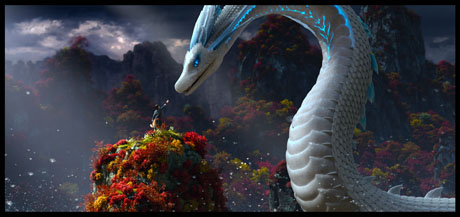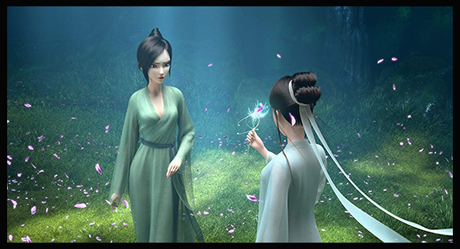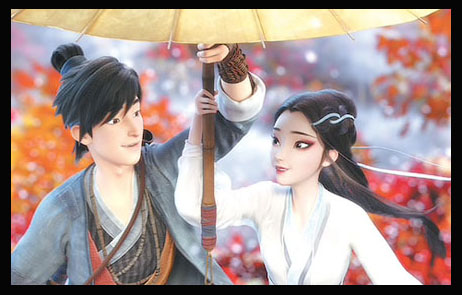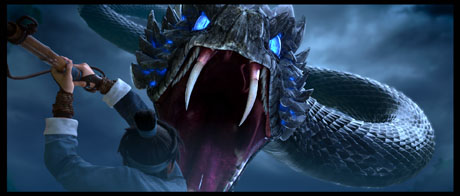
Five hundred years ago in China, during the late Tang dynasty, the Dark General made people catch snakes that somehow energize him with supernatural power. The snake people—demons—don’t like this.
So a beautiful young woman, Blanca, tries to assassinate him. She fails. Despite her martial arts prowess, she is subdued. She wakes in a remote village, her memory of who she is—and what she is—is gone. She befriends an athletically-inclined snakecatcher, and they embark on a journey to restore her memory and learn their purpose in life.
Thus begins White Snake, a CG-animated prequel to the popular Chinese folk tale, “The Legend of the White Snake.” The film was co-directed by Amp Wong and Ji Zhao for their Beijing-based studio, Light Chaser Animation , with Warner Bros. co-producing it. White Snake, a contender for Oscar consideration, had its American West Coast premiere at the Animation is Film Festival in Los Angeles on October 20th. At the festival, I visited with Ji Zhao to learn more about him, his studio, and his projects.

Bob Miller: What got you interested in animation?
Ji Zhao: Well, actually I graduated from animation school, in college [Ji attended Communication University of China and UCLA]. I think animation has a kind of power to absorb people into an imagination world. That attracts me a lot. When I was a kid, I grew up watching a lot of animated movies, either American Hollywood animation, or Chinese animation. But I never, growing up, thought I’d get a chance to really make an animated film. I learned making animation is a very, very difficult thing. You need a big team to help you finish it and to make a quality movie.
But, at the time in China, I didn’t see we had the chance to make animated movies. But a few years ago, I met the founder of our studio [Gary Wang, founder and ex-CEO of Tudou.com, China’s leading internet video website. He started Light Chaser Animation Studios in March 2013], and at that moment I knew when they got a chance to make our own CG animation in China.

Zhao Ji
JZ: (thinks) Oh, actually for me, animation, it doesn’t matter which way. It’s just the tools. But CG animation can create more reality, more live-action thing compared to hand-drawing, and it’s more easy to control somehow. Because everything you create is real, then you have to create the whole thing, and then you can shoot it like a [live-action] film, just in a 3D environment. So, that’s more convenient and easier for me to handle it in CG, because there’s very few hand-drawn animation in China, and cheap people. They don’t have that much cheap people doing that back there. Well, we do have some, but not a lot.
BM: So, your studio was one of the first in China to go CG?
JZ: Not first, but probably one of the major ones, I think. Well, it’s young company. We are six years old. I was there the first year when the company started up. It’s just not that much talent and animators in the Chinese industry, so I think at that time—back to six years ago—it was pretty hard to team up qualified teams to finish high-quality animation.
BM: Okay. So, is White Snake the first project for the studio?
JZ: It is actually the fourth.
BM: The fourth?
JZ: Yeah, we made three other feature animation films before. The other three are family animation films. Not that successful box office-wise, but they actually taught us a lot. Those films helped to train the team. In fact, I’m probably the oldest in the team, so we were a young crew, and they helped us to grow up, to understand the technology, and it also helped us to aim what we are going to do for the next few projects. So actually, we decided to do White Snake back in 2015.

BM: Did you get any of your crew from Oriental DreamWorks?
JZ: Not really, not really. Well, Oriental DreamWorks, I’m not quite sure about their team, but I heard most of their animation is still made in U.S. So only a few teams stay in China, Shanghai. I think they made two or three co-production films, like Kung Fu Panda 3, I guess a small portion made in China, but our film we made 100% in our studio.
BM: Where is your studio located?
JZ: Beijing.
BM: You basically trained your own crew?
JZ: Right, we grew up with the top three films and we’re still growing. We’re learning.
BM: You’re learning as you go. So were the earlier films just for the Chinese market, and White Snake is the first that you have a global audience in mind?
JZ: Actually it’s not. I think the first three films, we got better payback outside China than the Chinese market.
BM: Mainland China?
JZ: Mainland China. Our three earlier films were Door Guardians [aka Little Door Gods, 2016, available on Netflix as The Guardian Brothers] and Tea Pets [aka Toys and Pets, 2017], and Cats and Peachtopia [2018]? Yeah, those three movies actually got better box office outside mainland China than inside mainland China. But White Snake is probably the first one, we go to the U.S. and release here.
BM: Is your company financed by private investors, or the Chinese government, or both?
JZ: No, actually, we’re very private. It’s independent, we’re not part of government, no.

BM: What did you research for this film?
JZ: We did a lot of things. We went to some southern China to do the landscape. Basically, because this film happened in the late Han dynasty, which is two thousand years ago. We did a lot of research on that period of time. We found a lot of ancient drawings, old Chinese drawings. We want to re-make, re-create, that age, that look. For example, we have a city in the movie, like an ancient city, we literally found a map for during that time, and re-created the mapped buildings and mansions. We only had probably 25 seconds in the movie about that scene, but we did a lot of research on that, and we went through a lot of research to find the right material and style for the clothing for all the characters.
BM: So you actually re-created that city in 3-D?
JZ: Right.
BM: That’s impressive.
JZ: And also, for at the end of the movie we have a famous lake, that’s also the beginning of the original fairy tale, where Bianca and Xuan met on the bridge. Actually, that’s a very famous bridge on Hangzhou, China, that’s still there right now. We created that bridge, what it looked like a thousand years ago, when that scene happened.
BM: Were there any other filmmakers or anything that you drew inspiration from?
JZ: We actually got a lot of inspiration from … It’s not a traditional family film. The movie actually is aiming to young adults. Because, I don’t have kids. And my partner [Amp Wong], I mean the other director, he doesn’t have kids, so we’re not quite familiar with how to direct to children. So, we decide to make a story that we feel comfortable and we enjoy and we like and we understand. So we tell the story, White Snake, which is a love story, and the theme is about love. That’s not a family kind of thing, that’s more like a young adult. In a lot of interviews, we’ve mentioned we have sexual theme in there, but we’re not trying to just attract people’s eyes. It’s part of love, that’s why we put it there.

BM: What would you say to a Western audience to see your film? What is the appeal of your film, and what makes it special?
JZ: Okay. It’s a more of Chinese point of view, of young people’s love. Also, a lot of CG animation is made by Pixar, Disney, all those American major studios. With this technology, we can make our own style, our own art. For this film, we went to south China to find those beautiful landscapes and try to develop a unique Chinese look of the animation. And we want to show that as a quite different look than normal Hollywood film.
BM: Is this an original story or is this based off of Chinese legend?
JZ: It’s adapted, but based on a famous Chinese fairy tale, White Snake. It’s the same title, but we didn’t redo the same story. We actually did a prequel of the story, reaching five hundred years ago [during the late Tang dynasty] before the story. We took a younger version of the lady who thought herself as a human but actually, it turns out she is a snake spirit, but she falls in love with a boy. She falls in love with a human, so it’s kind of like an epic, forbidden love thing.
But, from the world’s point of view, in reality, more people will have deal with—not that extreme situation, but they may have situation where lot of people feel connected with this kind of thing.
Also, we think, for modern times in China—maybe U.S. as well—a lot of young girls feel insecure, unsafe about their marriage, about their relationship, because maybe they’re worried about, “What if I’m not that beautiful anymore?” or, “No, I’m getting fatter! Does he still love me?” Sometimes they worry about that, but in this movie we chose the perfect love that, even if turned into a monster, the love is come from soul, come from heart, not from what your shapes look like.

Zhao Ji and W.R. Miller
BM: Do you see a sequel for this, then?
JZ: We’re working on it. Actually, it’s in pre-production.
BM: Wow! You have faith in this concept.
JZ: Yeah. Well, actually, I’m working on something else right now, my next movie. I’ve already been working two, two-and-half years. Yeah, in China we do things fast. (laughs) So, yeah, in five years, our studio made four animated movies already, so the one I’m working on is the fifth, and the sequel should be the sixth.
Each one still lasts three or four years, because we overlap some. For example, I work [on one thing while] I work on during part of the time. A lot of work.
BM: Well, how well has White Snake performed in China?
JZ: For us, we feel very thankful and happy because box office turned out good. It was a box office hit [grossing RMB 449 million ($67 million) during its release earlier this year, from a budget of RMB 80 million ($11.3 million)] We earned the money. And I think more important is, this movie opened eyes for Chinese audiences. After White Snake, a lot of the audience began to believe that our local animation film is interesting, is funny, and they love to watch it, and they think “Oh, it’s not only for kids.” I’m more proud about this than the box office.
Although Warner Bros. co-produced the film, GKIDS is releasing The White Snake theatrically in the U.S. It opens November 15th, 2019 in Los Angeles, in select theaters on November 29th, 2019, expanding to additional markets thereafter.
Special thanks to Hilda Somarriba, Prism Media Group.
© Bob Miller
- INTERVIEW: Aaron Ehasz, Justin Richmond on “The Dragon Prince: Mystery of Aaravos”: The Right Choice for the Voice - March 20, 2024
- INTERVIEW: “The Dragon Prince” Influences, Inspirations, and the Mystery of Simpson - March 11, 2024
- INTERVIEW: The Magic of Her Voice: Paula Burrows of “The Dragon Prince” - October 4, 2023


 October 28th, 2019
October 28th, 2019  W.R. Miller
W.R. Miller  Posted in
Posted in  Tags:
Tags: 






